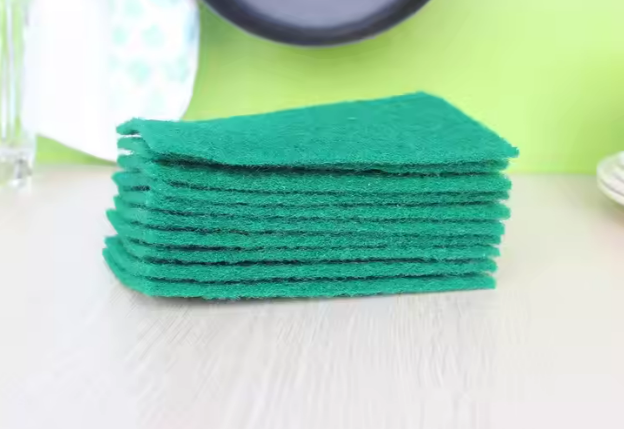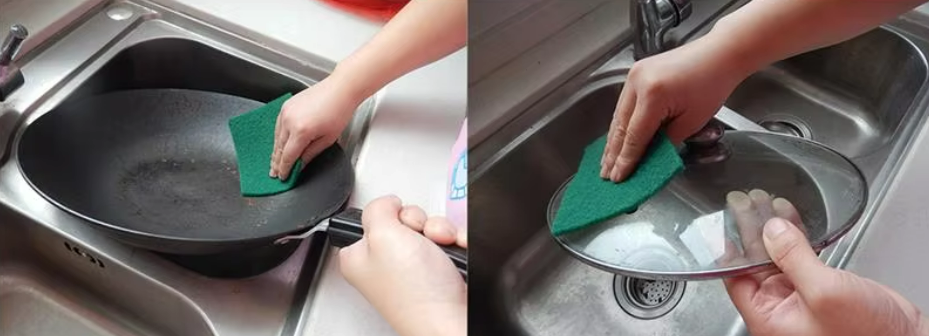If you’ve ever struggled to remove stubborn grease from a pan or scrubbed burnt residue off a baking sheet, you’ve likely reached for a scouring pad. But what exactly is this versatile cleaning tool, and how does it work? Here, we’ll break down everything you need to know about scouring pads—from their materials and types to their best uses and safety tips.
1. What is a Scouring Pad?

A scouring pad is an abrasive cleaning tool designed to tackle tough stains, stuck-on food, grease, rust, or mineral deposits through physical friction. Unlike soft sponges, scouring pads feature a rough texture that “scours” surfaces, making them ideal for heavy-duty cleaning tasks.
2. Materials: What Are Scouring Pads Made Of?
Scouring pads are crafted from materials that balance abrasiveness and durability. Common options include:
a. Metal-Based Pads
- Steel Wool: Made from fine steel fibers twisted into pads.
- Pros: Extremely abrasive, effective on rust and burnt residues.
- Cons: Can scratch surfaces; may rust if not dried properly.
- Copper Scourers: Softer than steel wool, ideal for copper cookware or delicate metal surfaces.
b. Synthetic Fiber Pads
- Nylon/Plastic Fibers (e.g., Scotch-Brite® pads):
- Pros: Durable, rust-proof, and moderately abrasive. Often color-coded (green for heavy-duty, blue for lighter tasks).
- Cons: Less effective on extremely stubborn stains compared to steel wool.
c. Natural Fibers
- Coconut Coir: Eco-friendly option made from coconut husks.
- Pros: Biodegradable and suitable for light scrubbing.
- Cons: Less durable than synthetic alternatives.
3. Types of Scouring Pads
Depending on your needs, scouring pads come in various forms:
| Type | Best For | Example |
| Standalone Pads | Heavy-duty scrubbing without a sponge layer. | Steel wool pads, copper scourers |
| Sponge Combos | Dual-sided (sponge + scouring pad) for multitasking. | Scotch-Brite® Dual-Action Sponge |
| Eco-Friendly Pads | Biodegradable options for sustainable cleaning. | Coconut coir pads, cellulose sponges with abrasive layers |
4. When to Use a Scouring Pad?
Scouring pads shine in specific scenarios:
a. Kitchen Cleaning

- Pots and Pans: Remove burnt food or baked-on grease.
- Oven Racks: Scrub off baked-in grime.
- Stainless Steel Sinks: Polish and eliminate water spots.
- Grills: Clean charred residues from grill grates.
⚠️ Avoid: Non-stick cookware, ceramic-coated surfaces, or polished stone (risk of scratches).
b. Bathroom Cleaning
- Tub/Shower Tiles: Scrub soap scum and hard water stains.
- Faucets: Remove limescale buildup.
c. Outdoor and Workshop Use

- Tools: Scour rust from metal tools.
- Barbecue Grates: Clean grease and char.
5. How to Use a Scouring Pad Safely?
- Test First: Check a small, hidden area to avoid scratching sensitive surfaces.
- Pair with Cleaners: Use baking soda, vinegar, or dish soap to boost effectiveness.
- Rinse Thoroughly: Residue from metal pads (e.g., steel wool) can cause rust.
- Replace Regularly: Worn-out pads lose abrasiveness and may harbor bacteria.
6. Alternatives to Scouring Pads
If you’re worried about scratches, try these gentler options:
- Baking Soda Paste: Mix with water for a non-abrasive scrub.
- Non-Scratch Sponges: Soft cellulose sponges for delicate surfaces.
- Magic Erasers: Melamine foam pads for marks on walls or appliances (avoid glossy surfaces).
Conclusion
A scouring pad is a powerhouse tool for tackling tough messes, but choosing the right type and material is key to protecting your surfaces. Whether you’re scrubbing a greasy stove or restoring a rusty tool, understanding the differences between steel wool, nylon pads, and eco-friendly options will help you clean smarter—not harder.
Pro Tip: Always label scouring pads by use (e.g., “kitchen only” or “outdoor”) to avoid cross-contamination!

